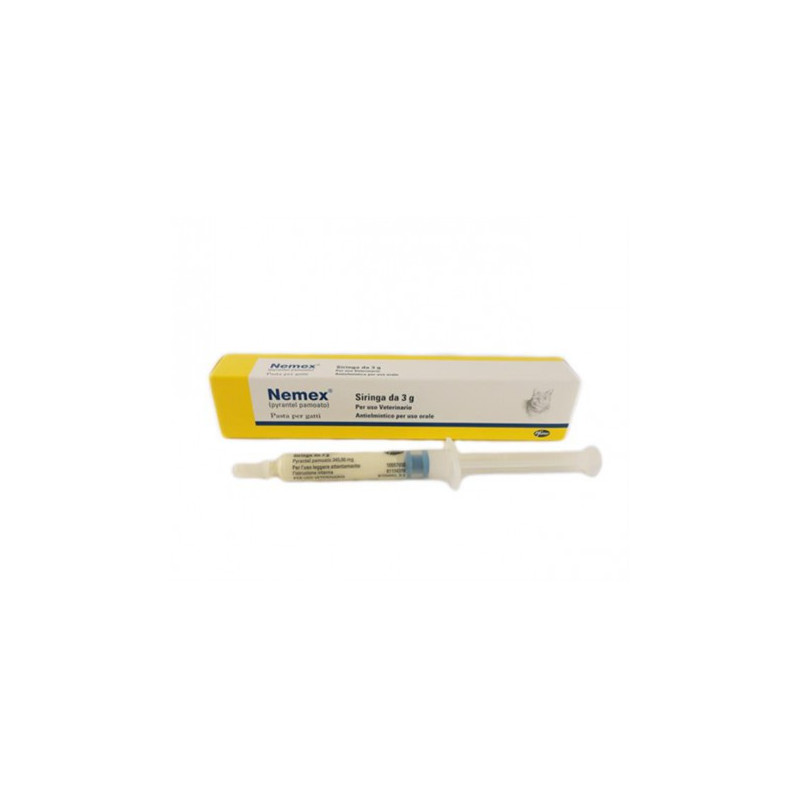

ParafarmaciaPet 080-8406035
PHARMACOTHERAPEUTIC CATEGORY: Anthelmintics.
COMPOSITION:
Active ingredients: Pyrantel pamoate 115.30 mg/g (equal to 40.0 mg/g of pyrantel base).
Excipients: Precipitated silica, propyl parahydroxybenzoate, methyl parahydroxybenzoate, sorbitol solution, sodium alginate, purified water.
INDICATIONS: It is indicated for the therapy and prevention of roundworm and hookworm infestations in kittens, pregnant and breastfeeding cats and adult cats.
INTERACTIONS:
CONTRAINDICATIONS/SIDE EFFECTS: Do not use in cases of hypersensitivity to the active ingredient or to one of the excipients.
PHARMACEUTICAL FORM: Paste
USE/ROUTE OF ADMINISTRATION: oral
DOSAGE: 57.65 mg of pyrantel pamoate equal to 20 mg of pyrantel base per kg of body weight of the cat. Method of administration: for ease of use, the following dosage is recommended. 2 g syringe: two syringe marks per kg of body weight. 3 g syringe: one syringe mark for every kg of body weight. It should be administered in a single time without keeping the cat on an empty stomach and without requiring it to follow a particular diet. The palatability of Nemex allows you to spread the preparation directly into the animal's mouth or, in the case of unsociable animals, mixed with food. Prophylaxis: Prophylaxis is carried out to keep the cat free from worms. Furthermore, prophylactic treatment allows the cat: to be more resistant to other diseases; you tolerate stress better; you have a more alert sensorium; has a better overall appearance, in particular with shinier fur. Prophylaxis program: 1. Kittens (up to 12 weeks of age): a first treatment should be carried out at 10-14 days of age. Subsequent treatments should be performed at weekly intervals until 2-3 weeks after weaning (approximately 5-7 weeks of age). If the probability of infestation still persists, it is advisable to proceed with further treatments up to the 12th week of age at 2-week intervals. 2. Young and adult cats (after 12 weeks of age): proceed with regular treatments every 3 months. In poor hygienic and/or environmental conditions, which favor the possibility of more frequent infestation, it is advisable to repeat the treatments at closer time intervals. 3. Cats: provide treatment 2, 4,6 weeks after each heat. Cats that have given birth should be treated at the 2nd, 4th, 6th, 8th and 10th week after giving birth. Outside of these periods and in good hygienic conditions it is sufficient to carry out disinfestation treatments every three months. Therapy: the treatment must be carried out immediately every time the presence of parasites is ascertained and repeated 2-3 weeks later. To ensure correct dosing, the plunger must be reset before dosing. Before administration, remove the cap, carefully press the plunger until the seal reaches the zero line and discard any leaked paste.
STORAGE: Do not store above 25 degrees C. Shelf life after first opening the primary packaging: use immediately.
WARNINGS: In case of dosage difficulties, for example when you are unable to weigh the cat, the dose to be administered must be rounded up. The preparation, in fact, below the indicated dosage does not fully demonstrate its therapeutic efficacy; on the contrary, high doses have no contraindications. Parasite resistance to any class of anthelmintics may develop after frequent and repeated use of an anthelmintic of that class. In order to achieve effective parasite control, treatment should be carried out based on the results of parasitological examination of feces. The medicine has a wide margin of safety and can be safely administered to subjects of all ages, in any physiological state (including pregnant and breastfeeding females) and in any state and severity of disease. Special precautions for those administering the veterinary medicinal product to animals: avoid contact with skin and eyes. Wash skin in contact with the product with water. Use gloves in case of hypersensitivity to the active ingredient or to one of the excipients. Overdose: the product has an excellent safety profile and a possible overdose is not capable of producing any adverse reaction both in kittens and in pregnant or breastfeeding females and in adult cats. Even if administered in doses 120 times higher than the therapeutic one and for several days it does not present symptoms of intolerance (vomiting, weight loss).
TARGET SPECIES: Cats
WAITING TIME: Not applicable.
INTERACTIONS: Do not use simultaneously with other cholinergics or cholinesterase inhibitors. Piperazine antagonizes the effect of pyrantel.
DIAGNOSIS AND PRESCRIPTION: Veterinary medicine without the obligation of a veterinary prescription.
SIDE EFFECTS: None known
PREGNANCY AND BREASTFEEDING: The product is specifically indicated for use during pregnancy and breastfeeding. During clinical trials using doses higher than those recommended, no side effects were found or reported.